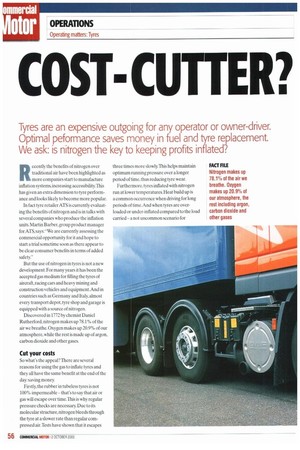COST CUTTER?
Page 56

Page 57

If you've noticed an error in this article please click here to report it so we can fix it.
Tyres are an expensive outgoing for any operator or owner-driver. Optimal peformance saves money in fuel and tyre replacement. We ask: is nitrogen the key to keeping profits inflated?
Rccently the benefits of nitrogen over traditional air have been highlighted as more companies start to manufacture inflation systems, increasing accessibility.This has given an extra dimension to tyre performance and looks likely to become more popular.
In fact tyre retailer ATS is currently evaluating the benefits of nitrogen and is in talks with several companies who produce the inflation units. Martin Barber. group product manager for ATS,says: -We are currently assessing the commercial opportunity for it and hope to start a trial sometime soon as there appear to be clear consumer benefits in terms of added safety."
But the use of nitrogen in tyres is not a new development. For many years it has been the accepted gas medium for filling the tyres of aircraft, racing cars and heavy mining and construction vehicles and equipment.And in countries such as Germany and Italy. almost every transport depot,tyre shop and garage is equipped with a source of nitrogen.
Discovered in 1772 by chemist Daniel Rutherford. nitrogen makes up 78.1°/0 of the air we breathe. Oxygen makes up 20.9% of our atmosphere. while the rest is made up of argon, carbon dioxide and other gases.
Cut your costs So what's the appeal? There are several reasons for using the gas to inflate tyres and they all have the same benefit at the end of the day: saving money.
Firstly, the rubber in tubeless tyres is not 100% impermeable — that's to say that air or gas will escape over time.This is why regular pressure checks are necessary. Due to its molecular structure, nitrogen bleeds through the tyre at a slower rate than regular compressed air.Tests have shown that it escapes three times more slowly.This helps maintain optimum running pressure over a longer period of time, thus reducing tyre wear.
Furthermore. tyres inflated with nitrogen run at lower temperatures. Heat buildup is a common occurrence when driving for long periods of time. And when tyres are overloaded or under-inflated compared to the load carried— a not uncommon scenario for commercial vehicle tyres— they are more likely to incur heat related damage.The reduction of running temperatures with nitrogen inflation compared to compressed air should reduce the likelihood of such incidence.Excessive heat damage can even result in tyre failure during use. Not a good situation.
Better road grip
Since nitrogen is a thy gas it eliminates the chance of moisture entering the tyre. something that can occur when using compressed air. During running, heat build up can turn trapped moisture into gas and increase the pressure within the tyre, which has the effect of reducing the size of its contact patch.
So what does that all mean in practical terms? To get an idea of the potential of using nitrogen compared to compressed air in tyres independent research was conducted involving 54 new 10.00 truck tyres. Of these, 33 were inflated with nitrogen and 21 were inflated with air.The tyres were run side by side on the same tractors until failure or until they wore to the tread wear indicators.
Nitrogen inflation resulted in 26% more miles being run before tyres had to be removed due to reaching their tread wear indicators. In the case of the failed tyres a smaller percentage of nitrogen tyres failed physically (30% vs 57%) and they gave 48% more miles before failing compared to the air tyres.
If you are interested in using nitrogen there are several points worth considering. Nitrogen is more expensive than compressed air and the cost effectiveness will depend on what kind of operation you are running.You will not reap the benefits if you only run a small number of vehicles. If this is the case then regular tyre checks should suffice.
Cost pressures
In the past if you wanted to use nitrogen you had to rely on bulky banks of high-pressure bottles for supplies of the gas. Space and cost were a disadvantage and limited its use for those who had a definite need for it.
However, the introduction of membrane technology has made it more accessible to the masses. Nitrogenbased tyre inflation systems (see box) use the same principle that causes air-filled tyres to lose their pressure. Compressed air is passed through special straw-like fibres. Smaller molecules like oxygen,carbon dioxide and water vapour diffuse through the mem branes.The larger nitrogen molecules stay within the fibres allowing a constant supply relatively pure gas for tyre inflation.
Nitrogen could be a powerful tool in you: campaign to raise profit margins —but it ne( to be used in conjunction with all that's best practice in tyre management and monitorir Put them all together and you could break mileage records. •




























































































































































































